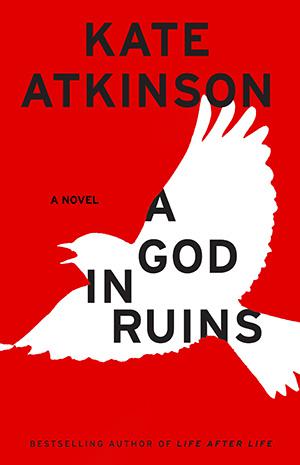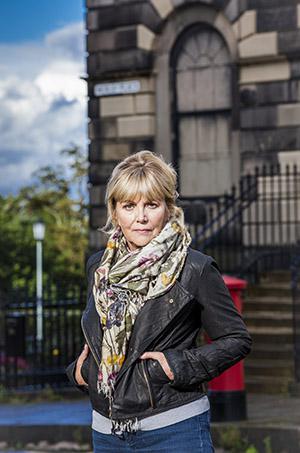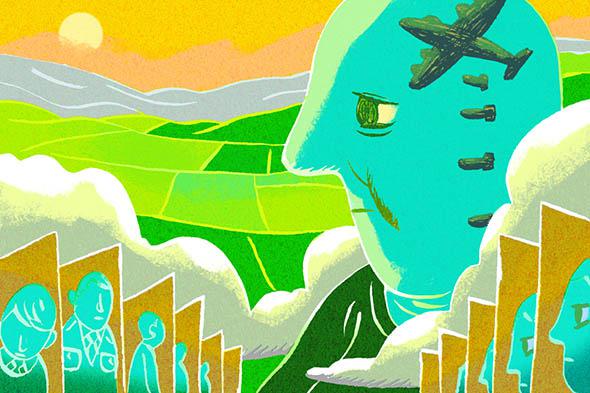Kate Atkinson’s best-selling 2013 novel Life After Life was a high-concept metafiction that repeatedly killed off its main character, Ursula Todd, only to resurrect her. Its new “companion” book, A God in Ruins, eschews that conceit: Characters live once, and die for good. But this only means Atkinson has found a quieter way to examine her favorite themes: fate, morality, art, and loss. (I’ll acknowledge upfront that there’s a different technical twist at the end.) In A God in Ruins—which traces the sunlit childhood, World War II RAF service, and nonagenarian twilight of Ursula’s brother Teddy—the world is still a Robert Frost poem refracted through an infinity mirror, crowded with views from the road not taken. But Atkinson’s tone has become more careful and meditative, as if she had set out to write the adagio second movement to Life After Life, and had substituted a single sad strain for the first’s flourish of melodies and countermelodies.
I’m thinking orchestrally because Atkinson excels at conveying bigness. She loads her observational, plot-driven prose with a sense of larger significance, of elements aligning. “What had gone into the making of Teddy?” she writes. “Not slugs or snails, it was true, but generation upon generation of Beresfords and Todds, all coming to one singular point in a cold bed in the chill of an autumn night when his father had caught hold of the golden rope of his mother’s hair and hadn’t let go until he had hauled them both to the far shore.” The cosmic scope stems in part from the austere and mythic beauty of the figures—golden rope, the shipwreck of the marital bed—and in part from Atkinson’s ability, in titrating large with small, the massed intentions of Teddy’s ancestors with the fragile contingency of that “one singular point,” to evoke the mysterious efficacy of fate. (Though don’t worry, cynics, the next line pokes fun at the seafaring metaphor.)
Elsewhere, Atkinson hints at an infinitude of other lives at the edges of her narration: Teddy’s daughter Viola on the beach wears a petticoat that “originally belonged to a shop girl who had died of consumption and who would have been shocked and not at all pleased to see her undergarments on display on a beach in Devon.” A bird is killed and a character’s mind goes to “the generations of birds that would have come after it. … All those beautiful songs that would never be sung.” This interest in the breadth of lives across the world feels like a counterpoint to the first book, which zeroed in on the depth of possible lives in one person. And the symbolism, bordering on allegory—larks and warplanes (and angels) blur together in the sky; Teddy remembers his childhood home as “an Arcadian dream”—persuades you that every detail matters, metaphysically, even if you can’t quite grasp how.

Image courtesy David Tipling/Alamy
I’m not criticizing. The book isn’t merely airy suggestion, in part because Atkinson grounds an occasionally sentimental focus on what Ursula calls “the numinous” in precise, wonderful descriptions of fighter planes (Lancasters, Halifaxes), cannon tracers, bomber streams, corkscrew starboard, and other specialized whatnot. That research sparks her empathetic imagination so that she delivers not just facts but texture, how the experience of war warps time: “Before it had been like a vast map—seemingly endless—that had been unrolled before him and on which he could choose in which direction to go. Now the map unrolled beneath his feet a step ahead at a time and might at any moment disappear.”
The novel has profound compassion for the English soldiers, “birds thrown against a wall, in the hope that eventually, if there were enough birds, they would break that wall.” Especially it loves Teddy, who is cheerful and plucky and brave in the manner of the Scouts with whom he spent his youth. Who is frugal and gentle to his resentful daughter and later tends his own bees and chickens. “I’m old-fashioned,” Teddy tells the repellent Viola, who with her drum circles and Magick and abhorrent, neglectful parenting could represent the folly of rebellion for its own sake. “I don’t think that’s a bad thing.”
There’s another reason the book’s aura of runaway significance—secret destinies and so on—didn’t bother me: For a book as meta as this one, the sense of an intentional universe—an authored universe—is hugely important. (Teddy himself, notably, is the inspiration for the main character in the popular children’s books his Aunt Izzie writes.) The world conjured by Atkinson’s god in ruins—a man, in other words, according to the epigraph, or perhaps a woman—is one suffused with fictionality, one in which small flickers and giveaways abound. In addition to the jumpy chronology (we move from 1925 to 1980 in the space of a page), Atkinson will present the same scene from multiple perspectives (never so painfully as when the intricate piano music Teddy’s wife, Nancy, believes herself to be playing turns out, in the next chapter, to be senseless banging, because she is dying from a brain tumor). Or the omniscient narrator will transcribe a ribbon of thought from one character—“Teddy knew he had failed Viola but he wasn’t sure how”—and then follow it with a parenthesis in which another character reacts to the thought as if it had been spoken out loud: “(‘Do you ever think it might be the other way round?’ Bertie said.)” This tic is jarring even the ninth or 10th time it happens, almost in the same way that Ursula’s 30th death in Life After Life still wrenched a little. It implies either that all the characters are telepathic or that every one of them arises from a single consciousness.
The upshot is that, throughout, it’s hard to shake the uncanny sense that you are meeting characters, seeing scenes, as they are in the process of being imagined by someone. Everywhere are strange echoes and contiguities, wisps of a previous setting threaded into a new one, as when the “armour” of “good manners” Teddy is told to “don anew every morning” reappears—anew!—in Viola’s conversation with her son several pages (and half a century) later. Or the red thread marking a flight path in 1945 comes back as the emergency cord dangling from the ceiling of the retirement home Teddy has moved to in 1993.

Photo by Euan Myles
These intimations of a meaningful, purposeful universe may play into the book’s sense of morality. Teddy, we are shown over and over, is good: kindhearted, honorable, selfless, brave. He risks his own safety for that of his crew, nurtures his reluctant grandchildren, and assiduously provides for his wife and child. All the WAFs and FANYs have “a pash” on him. Animals adore him. And fascinatingly the world that Teddy inhabits rewards him for his goodness—because he loves and is loved, he survives, as a character in his Aunt Izzie’s children’s books and in the broader fiction that is A God in Ruins. It all ties neatly into the sense, throughout Life After Life, that Ursula’s many attempts to “get it right” stemmed from her desire to save and protect Teddy, who deserves it. “When men are innocent,” reads the remainder of Atkinson’s epitaph from Emerson, “life shall be longer, and shall pass into the immortal.” Elsewhere, a character unearths a volume containing Keats’ “Endymion” and recites its opening line: “A thing of beauty is a joy for ever.”
When God falls into ruin, then, fiction becomes the moral force He can no longer be. The afterlife afforded by art—art created in loving memory of the dead—stands in for the spiritual ascent to paradise. That’s Atkinson’s beguiling premise, but also a problem for the book, because it speaks to what sometimes seems like the author’s frustrating, class-based conflation of ethics and aesthetics. “Worthy” characters, like Teddy, Bertie, and Ursula, are not just resourceful or kind. They have taste: appreciate nature, tremble with emotion when Beethoven plays, store snippets of fine English poetry in their mental “ragbag[s] of loveliness.” Meanwhile, the bad characters—Viola, especially—loathe the outdoors and regard animals with indifference. (Excoriated throughout as hypocritical and small-minded, Viola grows up to pen sappy mass-market chick lit for a living. Has Atkinson, who sharpened her teeth writing middlebrow mystery novels, never noticed that plenty of gorgeous, sensitive literary writers are jerks, too?)
Of course, parts of the novel push back against the troubling worship of beauty. We are not meant to admire “jeweled fireworks cascading in the black sky” when those flares are igniting the city below. A flak-stricken plane turns, nauseatingly, into a “falling leaf of fire” and Nancy knows she is sick when “a little shimmering line of gold that was actually rather pretty” bisects her field of vision. Still there is something underdeveloped, or overly broad, about good and evil in A God in Ruins. Teddy’s virtue can seem too simple, Viola’s vileness too insistently monochromatic. (In fact, Atkinson offers a credible—even sympathetic—explanation for the woman’s bad character, but that mercy is canceled out by the viciousness of her page-by-page realization. “The Ancient Mariner was lucky,” Viola reflects while visiting her aging dad. “His albatross was already dead before it was hung round his neck.” That is not a thought you give to a character you sincerely wish to give a fair shake.)
But if A God in Ruins suffers from a touch too much tidiness, if it overcalculates the glories of a sensitive “artistic soul,” those flaws pale next to Atkinson’s wit, humanity, and wisdom. In her afterword, she alludes to the “great conceit hidden at the heart of the book to do with fiction and the imagination, which is revealed only at the end.” It is a great conceit. But it’s also a testament to the novel’s craft and power that the conceit isn’t what you’ll remember when it’s over.
—
A God in Ruins by Kate Atkinson. Little, Brown.
See all the pieces in this month’s Slate Book Review.
Sign up for the Slate Book Review monthly newsletter.
